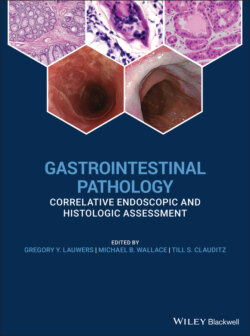Читать книгу Gastrointestinal Pathology - Группа авторов - Страница 105
Microscopic Features
ОглавлениеHistologic features can be found in asymptomatic patients (particularly children) and those with endoscopically normal appearing mucosa. Therefore biopsies are an important diagnostic tool. The findings include focal active mucosal infiltration with neutrophils and eosinophils, erosions, and ulceration. Erosions and ulcers are associated with an inflammatory infiltrate of the lamina propria and submucosa, which may contain histiocytes or small, poorly formed granulomas (Figure 2.23). Epithelioid granulomas are documented in up to 39% of esophageal biopsies, and in the proper clinical setting the presence of granulomas is considered diagnostic of Crohn’s esophagitis. Transmural inflammation has been documented in surgical specimens.
Crohn’s disease has also been associated with lymphocytic and eosinophilic esophagitis patterns of mucosal inflammation. The lymphocytic pattern is entirely nonspecific. Crohn’s disease‐related eosinophilic inflammation may be similar to allergic eosinophilic esophagitis, although the underlying immunologic mechanisms appear to differ.
